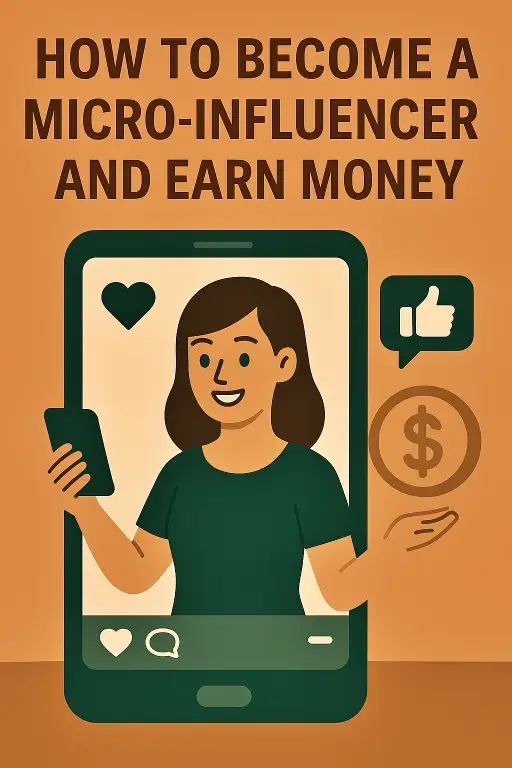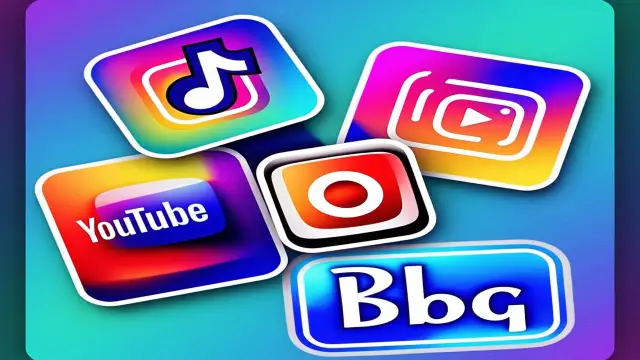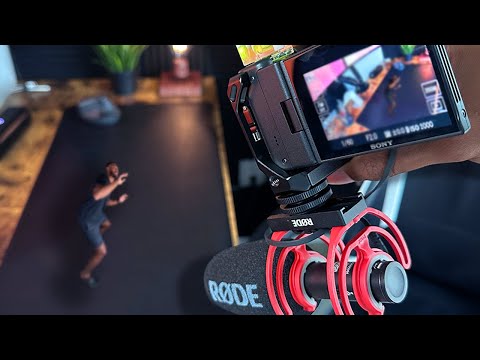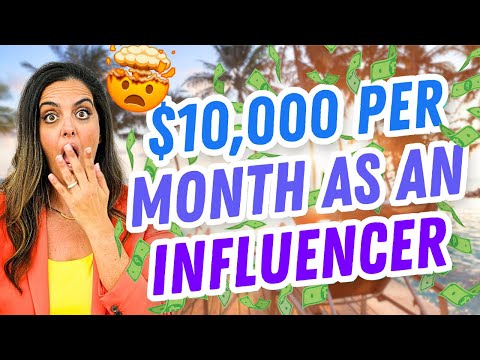Internet is buzzing with influencers, isn’t it? Every scroll through social media seems to reveal another individual sharing their life, their passions, and their recommendations. But the truth is, you don’t need millions of followers to make a real impact and some serious cash!
The landscape of online influence is shifting, and a new breed of content creator is rising to prominence: the micro-influencer. These individuals, often with a more modest following, are capturing the attention of both audiences and brands alike.
Table of Contents
What exactly is a micro-influencer?
It’s not about being a Kardashian-level celeb, that’s for sure! While the term “influencer” might conjure images of massive accounts with millions of followers, the reality for micro-influencers is quite different. Research consistently points to a follower range, typically between a few thousand and 100,000 across various platforms.
For instance, Aspire defines it as creators who have between 10,000 and 60,000 followers, while other sources like Grin and Sproutsocial set the upper limit at 100,000. Even Forbes suggests a range of 10,000 to 50,000 followers. It seems the sweet spot is somewhere in that range, wouldn’t you say? But it’s not just about the numbers, is it? Engagement and niche expertise are arguably more crucial. Soup Agency highlights that these influencers often offer niche expertise in specific areas and boast a highly engaged audience.
Qoints echoes this, noting that micro-influencers tend to position themselves as authorities on particular topics. Think of micro-influencers as your friendly neighborhood experts, deeply connected with their audience. Grin aptly calls them “friendly neighborhood influencers” who are easy to reach out to and super responsive. Aspire further emphasizes their relatability, describing them as “regular” people who have built impressive online followings.

Why the micro-influence movement?
Why are brands and audiences so drawn to these seemingly “smaller” players? Well, several compelling factors are at play. Studies consistently demonstrate that micro-influencers often have significantly higher engagement rates compared to their macro or mega counterparts. For instance, Sproutsocial cites a study showing that micro-influencers on Instagram can achieve an engagement rate of around 6%, considerably higher than the approximately 1.97% seen by mega-influencers.
Data collected by Upfluence, as noted by Code3, also supports this trend of higher engagement with smaller followings. Could it be because their audience feels more connected to them? Soup Agency suggests that micro-influencers foster genuine connections and trust due to their smaller following, leading to higher engagement. Furthermore, micro-influencers often specialize in specific areas, allowing brands to target very specific audiences. Grin points out that brands can leverage these niche communities to attract new attention to their products or target specific demographics. Code3 emphasizes that their most unique and valuable offering for brands is their audience targeting capabilities.
Think passionate communities, not just random followers. Moreover, followers often perceive micro-influencers as more genuine and trustworthy. Aspire notes that they operate in a sweet spot between online stardom and everyday relatability, fostering stronger relationships. Sproutsocial highlights that their audience is more likely to trust their recommendations.
Who are you more likely to trust a celebrity endorsing everything or someone who genuinely loves a specific product? Finally, micro-influencers are generally more affordable for brands, especially those with smaller budgets. Grin states that they are more affordable and may even accept product gifts. Sproutsocial emphasizes that they can help businesses reach a wider audience at a much more affordable price point. This opens up opportunities for more collaborations.
Could You Be One?
If you’re passionate about something and love connecting with others, the answer is likely a resounding yes!
The consistent follower range identified across numerous sources, generally between 1,000 and 100,000, with a concentration in the 10,000 to 100,000 range, indicates a broad understanding of what constitutes a micro-influencer. However, the advantages that brands seek in partnering with these individuals such as higher engagement, targeted reach within niche communities, and a sense of authenticity – consistently point to the importance of audience quality over mere quantity. The ability of micro-influencers to foster genuine connections with their followers, often stemming from their own passion and expertise in a specific area, appears to be a driving force behind their effectiveness.
The higher engagement rates observed among micro-influencers likely arise from the closer relationships they cultivate with their audience and their focus on specific interests. With a smaller, more targeted following, micro-influencers have the capacity to interact more directly with their community, responding to comments and messages, and creating a more personal connection. This direct engagement builds trust and fosters a sense of community among followers who share a common interest in the influencer’s niche. As a result, a larger proportion of their audience is genuinely invested in their content, leading to increased interaction and a greater likelihood of their recommendations being well-received.
Finding Your Niche: What Makes You You (and What Will Your Audience Love?)
Think about your passions, your hobbies, your expertise. What do you genuinely enjoy talking about? This is the starting point for finding your niche.

Identifying Your Sweet Spot: Your niche should be a blend of what you love and what others are interested in. Consider your unique skills, knowledge, or experiences. Micro-influencers often specialize in areas like
- Fitness.
- Fashion.
- Gaming.
- Finance.
as highlighted by Influencer Hero. What kind of content do you naturally gravitate towards creating?. Soulcial Mate suggests a “creator sprint” to experiment with different formats and topics to discover what resonates. Finally, is there an audience for it? Do some preliminary research on different social platforms to see if there’s a community interested in your potential niche. Creator Hero emphasizes finding a niche you’re passionate about, as this makes it easier to create and engage an active audience that shares your interests.
Examples of Niches: The possibilities are endless! Think specific hobbies (e.g., urban gardening, miniature painting, sustainable fashion) , lifestyle categories with a twist (e.g., budget-friendly travel for families, minimalist home decor for small spaces), or specific interests (e.g., vintage video games, artisanal coffee brewing, ethical beauty products).
The Benefits of Niche Focus: Why is niching down so important?
- First, you attract a more specific and engaged audience. This allows brands to reach the exact people who will be most interested in buying their product, according to Sproutsocial.
- Second, you become known as an expert in your field, building higher credibility. Micro-influencers often have this niche expertise, as highlighted by Soup Agency and Yellowhead.
- Finally, it’s easier for relevant brands to find and partner with you. This precise targeting ensures your message reaches the audience you’re looking for, as mentioned by Influencer Hero.
The emphasis on identifying a niche underscores a notable shift in how consumers seek information and recommendations. Instead of relying on broad endorsements from celebrities, individuals are increasingly turning to relatable figures who possess specialized knowledge in areas they are genuinely interested in. This suggests a growing value placed on focused content and authentic connections, making niche expertise a powerful driver of influence in the digital age. Brands, in turn, are recognizing the limitations of mass-market celebrity endorsements and are actively seeking out micro-influencers who can connect with specific, engaged communities, making a well-defined niche a significant advantage for aspiring micro-influencers.
Building Your Tribe: Creating Content That Connects and Converts
Once you’ve found your niche, it’s time to create content that will make people want to hit that follow button!
Crafting Engaging Content: It’s More Than Just Pretty Pictures, Isn’t It? While consistency is important (we’ll get to that!), your content needs to resonate with your audience. Creator Hero advises creating content you enjoy, not just to go viral; this passion will shine through. Tell your story; share your personal experiences, opinions, and expertise authentically.
- Yellowhead highlights that micro-influencers often share personal experiences, creating a sense of trust. People connect with real stories, don’t they? Experiment with different formats photos, videos, Reels, stories, blog posts, live streams.
- Soulcial Mate encourages trying every duration, format, and topic during your initial “creator sprint”. Provide value; offer helpful tips, tutorials, reviews, or entertaining content related to your niche.
- Creator Hero suggests simply sharing your passion. Visual appeal matters; high-quality visuals are crucial, especially on platforms like Instagram and TikTok.
- Scalefluence emphasizes the importance of attractive profiles and storytelling text in your posts.
Consistency is Key: Showing Up (Even When You Don’t Feel Like It)
Develop a regular posting schedule and stick to it as much as possible.
The Leap stresses the importance of a consistent posting schedule on TikTok, as both the algorithm and your audience reward it. Your audience will come to expect your content. Consider doing a “creator sprint” a dedicated period of consistent content creation without focusing on stats initially.
Soulcial Mate introduces this concept as mandatory when you’re first getting started, encouraging you to create and post consistently for a set duration. Save time by creating content in batches.
Engaging Your Followers: It’s a Two-Way Street, Folks!
- Respond to comments and DMs; show your audience you appreciate them by interacting with them. Creator Hero highlights that this genuine connection is a key aspect that sets micro-influencers apart.
- Ask questions and run polls; encourage interaction and get to know your audience better.
Creator Hero suggests using interactive features like Instagram polls, Q&A stories, and live sessions. Feature follower content; make your audience feel valued by sharing their relevant content. Go live; live sessions allow for real-time interaction and build a stronger connection.
The creation of consistent and engaging content forms the bedrock of audience growth and the development of strong community bonds. By regularly providing valuable and relevant material, micro-influencers can attract and retain a dedicated following. Furthermore, actively interacting with their audience, acknowledging their feedback, and fostering a sense of community cultivates loyalty and trust. This engaged and loyal audience becomes more receptive to the influencer’s recommendations and is more likely to interact with sponsored content, thereby increasing the micro-influencer’s attractiveness to brands and ultimately enhancing their potential to earn money. Brands recognize that influencers with high engagement are more likely to deliver results.
Where Will You Shine? (Instagram, TikTok, YouTube, Blog or Maybe All of Them?)

Not all platforms are created equal! Consider where your niche and content style fit best.
- Instagram: This visual powerhouse is ideal for visually-driven niches like fashion, beauty, and lifestyle. Creator Hero notes Instagram’s suitability for these areas, where high-quality images and short videos thrive. It’s known for its high engagement rates for micro-influencers and utilizes hashtags and influencer discovery features effectively. There’s an increasing trend of brands prioritizing micro-influencers on this platform. In fact, Business Insider reports that a significant 57% of marketers now prioritize working with micro-influencers on Instagram over larger names.
- TikTok: This platform reigns supreme for short-form video, making it great for trends, challenges, and creative content across various niches. Studio Socials highlights TikTok’s rapid growth in popularity and its ability to reach a wide audience in a creative and engaging way. Its algorithm prioritizes engagement, offering opportunities for smaller creators to go viral. This helps level the playing field by giving creators with smaller audiences the chance to gain reach, as noted by Longdash. TikTok boasts high user engagement and a predominantly younger audience. Brands are increasingly recognizing the value of micro-influencers on TikTok. Taylor & Francis Online even indicates that TikTok has become the most popular influencer marketing channel, surpassing Instagram for the first time.
- YouTube: This platform is ideal for long-form content like tutorials, reviews, and in-depth storytelling. Influencer Hero points out that YouTube’s long-form video format supports in-depth storytelling and allows influencers to deliver comprehensive product reviews, fostering audience connection. It offers high searchability and SEO benefits. QuickFrame notes that YouTube is the second-largest search engine in the world. It also fosters strong subscriber loyalty.
- Blogging: This offers a space for more detailed written content, allowing you to build authority and drive organic traffic. Blogger Hangout highlights micro-influencer blog marketing as a powerful strategy for expanding reach and engaging new audiences. It allows for a genuine and authentic connection with your audience, and your niche expertise can lead to highly relevant content.
Don’t be afraid to cross-pollinate! Many successful micro-influencers have a presence on multiple platforms, repurposing content and reaching a wider audience. Scalefluence even suggests repurposing your TikTok videos for massive engagement on Instagram, highlighting the potential for broader reach.
The increasing popularity of TikTok for micro-influencers signifies the growing power of short-form video content and the platform’s unique algorithm. Unlike platforms that heavily rely on follower count, TikTok’s algorithm prioritizes engagement, enabling creators with smaller audiences but compelling content to achieve significant visibility and rapidly build engaged communities. This has led to the emergence of many “everyday influencers” who are seen as more authentic and credible than traditional celebrities.
Brands are increasingly recognizing this dynamic, shifting their marketing budgets towards micro-influencers on TikTok due to their cost-effectiveness, high levels of audience interaction, and ability to connect with specific niche demographics. This trend suggests that for individuals looking to become micro-influencers, TikTok presents a significant opportunity for growth and monetization in the current digital landscape.
How Micro-Influencers Actually Earn
Alright, let’s talk about the exciting part getting paid for your passion!
Instagram: From Sponsored Posts to Reels Bonuses – Let’s Get Real Sponsored posts are a primary way to earn, where brands pay you to create content featuring their products or services. Madeline Bajczyk, a fashion micro-influencer, has shared her experiences working with numerous national brands, demonstrating the potential. Rates can vary significantly based on your follower count and engagement, but micro-influencers can generally earn anywhere from a few hundred to a few thousand dollars per post. Selzy notes an average of around $1,516 per post for micro-influencers, although this can fluctuate.
Affiliate marketing is another popular strategy, where you promote products using unique links or codes and earn a commission on any resulting sales. Scalefluence points out that this method allows you to earn even without direct brand sponsorships. If you have your own merchandise, digital products, or services, Instagram provides a great platform to sell them directly to your audience.
Instagram has also been known to offer bonuses to creators for posting engaging Reels content. Stack Influence reports on Instagram offering substantial cash bonuses to TikTok influencers to prioritize posting on Reels. For those who frequently use Instagram Live and have a dedicated audience, the Badges feature allows followers to purchase them to show support during live videos (this typically requires over 10,000 followers). Similarly, the Instagram Subscriptions feature allows you to offer exclusive content to paying subscribers, also generally requiring a follower count of 10,000 or more.
TikTok: Dancing Your Way to Dollars? Exploring Monetization Similar to Instagram, sponsored posts are a significant way to earn on TikTok, with brands paying for promotional content. Studio Socials identifies this as the most common monetization method for TikTok micro-influencers. Rates for micro-influencers can range from around $50 to $2,000 per campaign, depending on factors like follower count and engagement.
Billo provides these typical sponsorship payment ranges. Affiliate marketing, where you promote products with affiliate links and earn commissions on sales, is also a viable option. If you have your own products, you can utilize TikTok Shop to sell merchandise or digital offerings directly through the platform. TikTok’s Creator Rewards Program allows you to earn money based on the views your videos receive, although specific eligibility requirements apply. The Leap notes that this program aims to provide higher earning potential compared to the original Creator Fund.
During live streams, viewers can send virtual gifts, known as LIVE Gifts, which you can then exchange for cash. For creators with exclusive content, TikTok Series allows you to put collections of videos behind a paywall, offering another avenue for direct monetization. Finally, you can also earn by creating User Generated Content (UGC) for brands to post on their own TikTok accounts.
YouTube: Beyond Adsense – Making Your Videos Pay Sponsored videos, where brands pay for integrations or dedicated videos featuring their products, are a common revenue stream on YouTube. ProTunes One provides earning estimates for micro-influencers, suggesting a range of $100 to $500 per post. Just like other platforms, affiliate marketing involves including affiliate links in your video descriptions to earn commissions on sales. You can also leverage your YouTube channel to promote and sell your own merchandise, online courses, or other digital products to your audience.
For those who meet specific criteria, such as a minimum number of subscribers and watch hours, the YouTube Partner Program (Adsense) allows you to earn revenue from ads displayed on your videos. ProTunes One notes that creators in the YPP typically earn 55% of the revenue generated from these ads. Channel memberships offer a way to provide exclusive content and perks to viewers who pay a recurring fee. Finally, during live streams, viewers can purchase Super Chat and Super Stickers to highlight their messages within the chat.
Blogging: Turning Your Thoughts into Income Affiliate marketing is a fundamental way to monetize a blog, involving the integration of affiliate links within your content. Upwork highlights this as an excellent way to generate passive income once you have a blog with a following. Partnering with brands to create sponsored blog posts or reviews is another common and effective monetization strategy. Creating and selling digital products, such as ebooks, online courses, or templates, allows you to directly monetize your expertise and content.
Display advertising, through platforms like Google AdSense, involves placing ads on your blog and earning revenue based on the number of impressions or clicks they receive. Offering premium content or memberships, where users pay a subscription fee for exclusive access, can provide a steady revenue stream. Finally, if your blog focuses on a specific skill or area of expertise, you can offer your services as a consultant, coach, or freelancer directly to your audience.
Micro-influencers have a wealth of monetization options available to them across various platforms. The key to building a sustainable income often lies in diversifying these strategies and exploring multiple avenues simultaneously. By combining methods like sponsored content, affiliate marketing, and selling their own products or services, micro-influencers can create a more resilient and potentially more lucrative income stream than relying on a single approach.
For instance, a micro-influencer passionate about sustainable living could earn through sponsored posts featuring eco-friendly brands on Instagram, share affiliate links to their favorite sustainable products on their blog, and offer a digital guide on minimalist living for sale on their YouTube channel. This multi-faceted approach not only maximizes earning potential but also allows the influencer to connect with their audience in different ways and build a stronger overall brand.
Authenticity, AI Bypassing, and Google’s Good Graces
In today’s digital world, being genuine is more important than ever. And let’s not forget about those pesky AI detectors and Google’s rules!
Authenticity is Your Superpower: Followers can spot inauthenticity a mile away. Yellowhead emphasizes that genuine and relatable content is a hallmark of micro-influencers. The Leap also values authenticity highly on TikTok, noting that consumers are drawn to it.
Share your genuine opinions and experiences. Only promote products or services you truly believe in. Be transparent about sponsored content using appropriate disclosures. The Leap highlights that transparency is as valued as authenticity on TikTok, urging creators to use the Branded Content toggle for sponsored posts.
The consistent emphasis on authenticity as a defining characteristic of successful micro-influencers across various platforms reflects a significant shift in consumer attitudes towards advertising. There’s a growing skepticism surrounding traditional, often polished, endorsements from larger influencers. Instead, consumers are increasingly seeking out genuine and trustworthy recommendations from individuals they perceive as being relatable peers or knowledgeable experts within specific areas of interest.
This trend underscores the critical importance of authenticity for micro-influencers who aim to build a loyal and engaged audience and secure meaningful partnerships with brands. To maintain this crucial trust, micro-influencers must be selective about the brands they choose to collaborate with, ensuring that these partnerships align with their own values and resonate authentically with their followers.
Pro Tips for Micro-Influencer Success
Ready to take things to the next level? Here are some extra tips to help you shine.
- Build Relationships with Brands: Don’t wait for them to come to you! Reach out to brands you love and align with. Grin suggests actively looking among your existing followers and customers for potential collaboration opportunities. Create a media kit showcasing your audience demographics, engagement metrics, and content style. Madeline Bajczyk specifically mentions creating a media kit as a key step in her guide to earning money on Instagram. Personalize your outreach and clearly explain why you believe you would be a good fit for the brand. As a Reddit thread points out, getting on a brand’s PR list is all about demonstrating your value and making it easy for them to say yes.
- Network with Other Influencers: Collaborate with others in your niche to expand your reach and tap into new audiences. Anthony McLemore on YouTube suggests that collaborations are a valuable way for micro-influencers to gain exposure to different niches and audiences.
- Analyze Your Performance: Pay close attention to your analytics to gain insights into what content resonates most effectively with your audience. Grin advises regularly monitoring your performance metrics. Soulcial Mate emphasizes the importance of dissecting the data you gather after a content creation sprint to identify what works best.
- Stay Up-to-Date: Continuously learn about the latest trends, algorithm changes, and best practices in the ever-evolving world of social media and influencer marketing.
- Consider Using Influencer Marketing Platforms: These platforms can act as valuable bridges, connecting you with brands that are actively seeking micro-influencers for collaborations. Scalefluence is one such platform that specifically helps influencers in all niches connect with brands and marketing agencies.
- Don’t Be Afraid to Say No: Only partner with brands whose values align with your own and whose products or services you genuinely believe in and would recommend to your audience.
Proactive outreach to brands, especially when coupled with a well-prepared media kit, can significantly improve a micro-influencer’s chances of securing paid collaborations. While some partnership opportunities may arise organically, taking the initiative to connect with brands that align with your niche and values demonstrates professionalism and a genuine interest in collaboration. A comprehensive media kit provides brands with crucial information about your audience, engagement rates, and content style, enabling them to readily assess whether you would be a suitable partner for their marketing campaigns.
By proactively presenting this information, micro-influencers can effectively showcase their unique value proposition and increase their likelihood of being chosen for brand partnerships, thereby unlocking valuable monetization opportunities. This is particularly important for micro-influencers who may not yet have the extensive reach of larger influencers and need to actively demonstrate their potential value to brands.
Conclusion: Your Journey to Becoming a Paid Micro-Influencer – Are You Ready?
Becoming a successful and paid micro-influencer takes time, effort, and dedication. It requires passion for your chosen niche, consistency in creating engaging content, and a genuine desire to connect with your audience. But with these elements in place, and by leveraging the strategies outlined in this guide, it’s absolutely achievable.
So, what are you waiting for? It’s time to share your unique voice with the world and maybe even make a little (or a lot!) of money while you’re at it. Ready to take the plunge?
Key Tables:
Table 1: Micro-Influencer Follower Count Tiers
| Source | Follower Count Range |
| soup-agency.com | Few thousand – 100K |
| grin.co | 10K – 100K |
| code3.com | 10K – 100K |
| sproutsocial.com | 10K – 100K |
| aspire.io | 10K – 60K |
| viralnation.com | 10K – 100K |
| soup-agency.com | 1K – 100K |
| giraffesocialmedia.co.uk | 5K – 100K |
| forbes.com | 10K – 50K |
| captions.ai | 10K – 100K |
| entrepreneur.com | 10K – 100K |
| viralnation.com | 10K – 100K |
| quora.com | 1K – 100K |
| lionize.ai | 1K – 100K |
| socialnative.com | 10K – 100K |
| sprinklr.com | 10K – 100K |
| brand24.com | 10K – 50K |
| researchgate.net | 1K – 100K |
| influencer-hero.com | 1K – 100K |
| sevenatoms.com | 1K – 100K |
| qoints.com | 1K – 100K |
| yellowhead.com | 10K – 100K |
| marketcast.com | 10K – 100K |
| bloggerhangout.com | 1K – 100K |
| bcvsocial.com | 2K – 40K |
| curemedia.com | 10K – 50K |
| contentdevelopmentpros.com | 1K – 100K |
Table 2: Monetization Strategies by Platform
| Platform | Monetization Strategies |
| Sponsored Posts, Affiliate Marketing, Selling Own Products, Instagram Bonuses, Badges (Live), Instagram Subscriptions | |
| TikTok | Sponsored Posts, Affiliate Marketing, Selling Own Products, Creator Rewards Program, LIVE Gifts, TikTok Series, UGC Content for Brands |
| YouTube | Sponsored Videos, Affiliate Marketing, Selling Own Products, YouTube Partner Program (Adsense), Channel Memberships, Super Chat and Super Stickers |
| Blogging | Affiliate Marketing, Sponsored Posts and Brand Collaborations, Selling Digital Products, Display Advertising (e.g., Google AdSense), Offer Premium Content or Memberships, Offer Services |




